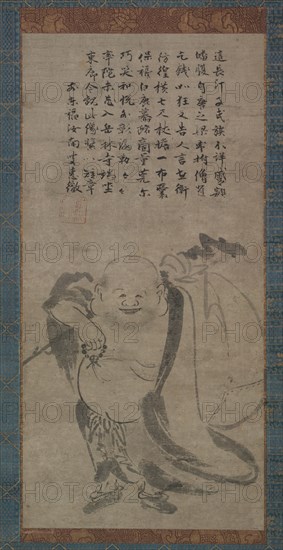
Sujet
Hotei, late 1400s. Creator: Jonan Etetsu (Japanese, 1444-1507).
Légende
Hotei, late 1400s. The Zen monk Jonan Etetsu is recorded as the 183rd abbot of To fuku-ji temple in the eastern hills of Kyoto, one of the earliest and most influential Zen institutions in medieval Japan. Otherwise, the only biographical information known to date has been gleaned from a few inscriptions on paintings documenting his friendship with another eminent monk, Ryo ?an Keigo (1425-1514), and two paintings bearing Jonan?s own poetic inscriptions. This image of Hotei (Chinese: Budai), a legendary, 10th-century Chan (Zen) monk, is one of those paintings. In Japan the image of the mirthful, pot-bellied Hotei enjoyed great popularity from the 14th century onward. Zen literature and popular folklore merged to create a storehouse of attractive fiction concerning this delightful character?s worldly adventures as a kind of itinerant Santa Claus and more symbolically as the future Buddha, Miroku, in disguise. For the Japanese, Hotei came to represent an unfettered path to spiritual enlightenment. The identity of the artist of this painting is unknown, although it may have been Etetsu, who attained a high rank within the 15th-century Zen community.
Crédit
Photo12/Heritage Images/Heritage Art
Notre référence
HRM19F86_078
Model release
NA
Property release
NA
Licence
Droits gérés
Format disponible
73,0Mo (6,2Mo) / 30,7cm x 59,6cm / 3625 x 7037 (300dpi)